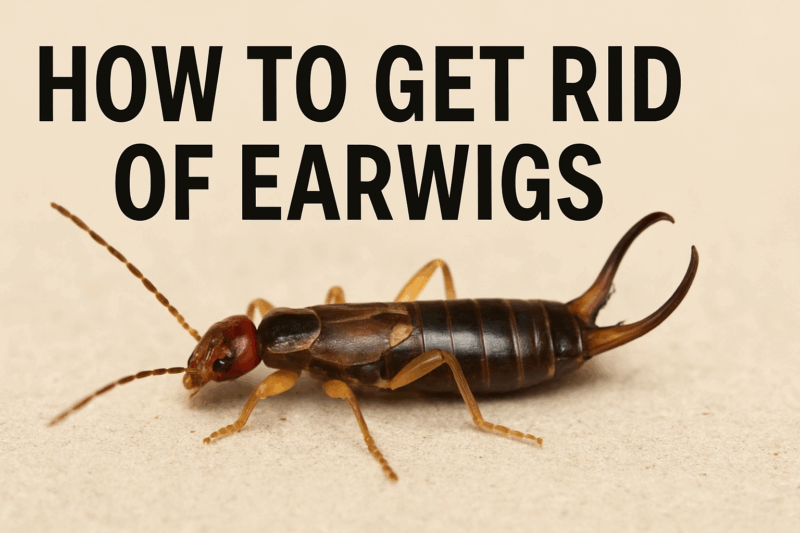Earwigs are nocturnal, creepy-looking bugs with a misleading reputation for burrowing into people’s ears and laying eggs, which they do not. Instead, earwigs in the house indicate that your home provides a moist, safe environment for them. They can harm plants and cause minor annoyance when they pinch, but they are generally useful to the ecosystem.
Continue reading to learn about twelve of the most effective natural ways on how to get rid of earwigs in your home without using dangerous pesticides or harming the environment.
What Do Earwigs Look Like?

Before you can get rid of earwigs, make sure the insect in your home is an earwig. Earwigs are long, flat, wriggly creepy-crawlies with six legs. Some have wings, while others do not, but they are best known for their frightening cerci, or pair of curving pincers that emerge from the end of their abdomen.
SEE MORE ARTICLES
How to Make Sea Salt Spray for Hair
How to Make Scents Last Longer
How to Make Moist Cornbread from Jiffy Mix
How to Make Privacy Fence Step by Step
How to Get Rid of Earwigs in House
1. Control Moisture Around Your Home
This is the most crucial action you can take. Earwigs are highly drawn to wetness; thus, leaky faucets and drains are ideal entry locations for these pests. Consider moisture control as your first line of defense.
Begin by strolling around your house, checking for any water issues. Check under sinks, around toilets, and near the water heater. Fix any leaking pipes or faucets you discover. Even little drips might generate the wet conditions that earwigs prefer.
Use a dehumidifier in the basement to eliminate excess moisture and enhance airflow in humid areas such as bathrooms. Make sure your bathroom fans are working properly and use them when showering.
Outside, ensure the gutters and downspouts are clear and correctly draining away from the home to avoid moisture buildup, which may attract earwigs. Clogged gutters provide ideal breeding conditions for these insects.
Don’t forget to inspect for “sweating” pipes and repair any spots where water may be gathering. The drier you can maintain things, the less appealing your home is to earwigs.
2. Seal the entry points and cracks.
Sealing these potential entryways will help to avoid earwig invasions. To fix gaps and cracks around your foundation, apply caulk, concrete patch, or weather stripping.
Examine your home’s exterior for any cracks or holes. Pay specific attention to the points where pipes or cables enter your property. These are like bug highways. To seal tiny gaps, use caulk, and for larger ones, use a concrete patch.
Install door sweeps on external doors, and inspect all window screens for tears or holes. Earwigs can fit through even the smallest gaps.
Pay special attention to ground-level entry sites, as this is where earwigs are most likely to find their way in. Check the area surrounding your foundation, basement windows, and any doorways that lead to basements or crawl spaces.
Weather stripping around doors and windows not only keeps bugs out, but it can also reduce your energy expenditures. This is a win-win solution.
3. Remove outdoor hiding places.
Earwigs require somewhere to hide throughout the day; thus, removing their favorite hangout locations makes your yard less appealing to them.
Keep mulch, dead leaves, and other vegetation 6 to 12 inches from your house’s foundation. This generates a “dry zone” that earwigs avoid crossing.
Maintain a regular yard clean-up schedule. Remove any mounds of leaves, stacks of newspapers, timber, or other clutter that could be hiding places for insects. Trim trees and shrubs to eliminate wet, shady places, particularly near the house.
If you use mulch in your garden, think about converting from organic mulch (like wood chips) to inorganic mulch, such as gravel or stone. Organic mulch retains moisture and provides ideal breeding conditions for earwigs.
Maintain short grass and swiftly eliminate any dead plant material. The idea is to eliminate as many dark and wet hiding places as possible.
4. Create DIY Oil and Soy Sauce Traps
This is by far the most effective DIY earwig trap and an excellent solution for how to get rid of earwigs organically. The smell of soy sauce will draw them in, and the oil will prevent them from climbing out.
Here’s how to create these really effective traps:
- Combine the vegetable oil and soy sauce in a small container in equal parts. Usually, 1/4 cup of vegetable oil and 1/4 cup of soy sauce work well.
- Bury the container in your garden so that the top is level with the earth. This makes it easy for earwigs to locate and fall into.
- To protect the trap from rain, cover it with a wide plastic lid or a plant pot saucer. Use stones to prop up the cover, leaving small holes for bugs to creep under.
- Place these traps in areas where you’ve noticed plant damage or earwig activity. For larger gardens, place many traps across the area.
- Check your traps every few days and remove the dead bugs. Then, refill with new oil and soy sauce. Soy sauce is commonly employed as an excellent bait in earwig traps due to its unique chemical qualities, which make it irresistible to these pests.
5. Set Up Newspaper and Bamboo Tube Traps
These basic traps work because earwigs seek out gloomy areas to hide during the day.
For newspaper traps, wrap up an old newspaper to form a tube. It’s vital not to roll it too tightly since the earwigs need room to enter the trap. Dampen the newspaper with water and place it in dark areas where you’ve observed earwigs.
Place 1-foot sections of bamboo or garden hose in the spaces between your plants. Check these “traps” every morning and throw the earwigs into a pail of soapy water.
The newspaper approach is excellent for dealing with indoor earwigs. Place wet newspaper tubes in basements, garages, or anywhere you’ve seen these bugs. After a few days, carefully pick up the newspaper (while wearing gloves) and discard it in a sealed bag or shake the bugs into soapy water.
Garden hose pieces function in the same way. Cut old hoses into foot-long sections and place them throughout your garden. Earwigs will climb inside to hide, and you may shake them out into a bucket the next morning.
6. Apply diatomaceous earth (food-grade).
Diatomaceous earth is an effective, natural technique for managing earwig infestations indoors and outdoors. The microscopic dust pierces through their exoskeletons, killing them within 48 hours of contact.
Only use food-grade diatomaceous earth (DE), which is suitable for children and pets. Pool-grade chemicals are hazardous and should never be used for pest control.
Sprinkle a thin layer of DE around the base of any plants that earwigs have damaged. You can also apply it to the foundation of your home or anywhere you’ve noticed earwig activity.
A thin coating is usually sufficient. Thick mounds of DE may prevent earwigs from crossing completely, reducing their effectiveness.
The problem is that DE stops functioning when wet, so you’ll need to reapply after rain or irrigation. In rainy weather, DE is ineffective. DE will also damage pollinators, so avoid using it near flowers.

7. Use Essential Oil Deterrents
Some essential oils, like peppermint, lavender, and citrus oils, have insect repellent characteristics that can help keep earwigs away.
Making your own essential oil spray is quite simple. Add a few drops of peppermint, eucalyptus, lavender, or citrus oil to a water-filled spray container. Shake thoroughly before each usage.
Spray this solution around doorways, windowsills, and anywhere you’ve spotted earwigs. You can also spray it directly on injured plants.
Strong fragrances such as eucalyptus, cinnamon, peppermint, and lemon have been proven to be excellent deterrents.
The oils lose their power over time, so reapply the spray every few days or after rain. Plant scented herbs like lavender and peppermint around your home to provide natural, continuing protection.
When the oils are properly diluted, this procedure is perfectly safe for both humans and animals.
8. Develop alcohol-based contact killers.
Alcohol eliminates these pests by acting as a surfactant, or wetting agent, allowing it to penetrate an insect’s waxy covering of armor and kill it on contact.
To prepare an insecticidal spray, mix equal parts 70% alcohol and water. If using 95% alcohol, mix 1 part alcohol and 1 ½ parts water.
This spray must come into contact with the earwigs to be effective; thus, it’s ideal for spot treatments when the bugs are visible. Earwigs are most active at night, so you may need to go bug hunting with a flashlight.
Use normal rubbing alcohol from the drugstore, but make sure it contains no chemicals or scents. The regular product works best and is the safest to use in your house.
Keep a spray bottle of this mixture accessible for swift action when you see earwigs. It kills them virtually immediately upon contact.
9. Apply Neem Oil Treatment.
Neem oil is a vegetable oil derived from the fruits and seeds of neem trees that are native to India. It’s a popular natural 3-in-1 pesticide for controlling insects that feed on plants.
Spray the damaged areas of your garden with a mixture of neem oil and water, as directed on the packaging. Make sure to spray in the evening, when earwigs are most active.
Neem oil functions in two ways. First, it coats plant leaves with an oily covering, making it difficult for insects to feed. Second, it disrupts their growth hormones, reducing their population over time.
This treatment works best on juvenile earwigs and requires several applications to be effective. Follow the directions on your neem oil product to get the proper mixing ratio.
Important warning: Neem oil is lethal to bees and can destroy an entire hive. Avoid using it on flowering plants or in areas where bees are active in your garden.
10. Use Light Traps for Outdoor Control
A simple light trap can be extremely efficient for managing earwigs. All you have to do is fill a cup or bucket halfway with a soap and water solution and shine a fixed light on it.
Some earwigs are drawn to lights at night, particularly near porches and patios. You can use this against them by installing simple light traps.
Fill a container with soapy water and shine a bright light on it. Earwigs will come to explore the light and fall into the water, where the soap stops them from climbing back out.
This works well during peak earwig season (late spring or early summer) and in regions where earwigs have been spotted clustering near outdoor lights.
You may also make your outdoor lighting less appealing to bugs by upgrading to LED bulbs or using yellow or orange lights instead of dazzling white ones.
11. Encourage natural predators.
Birds and toads are natural earwig predators. Instead of fighting earwigs, you can get their natural enemies to do the work for you.
Invite natural earwig predators, such as birds and toads, into your garden. Set up bird houses, bird baths, and feeding stations to entice birds to your yard.
Make toad-friendly regions by providing shallow water dishes and leaving some portions of your garden to grow wild. Toads prefer to hide beneath rocks and logs during the day.
Avoid applying broad-spectrum pesticides, which kill both helpful and dangerous insects. When you have a healthy ecosystem in your yard, the beneficial bugs and animals help to naturally control pest numbers.
Plant native flowers and bushes to attract beneficial insects. These critters compete with earwigs for food and territory, which helps to keep their numbers low.
12. Call Professional Pest Control Services
Sometimes the situation is too enormous to address on your own. This is when it makes sense to hire professionals.
When to call a professional:
- You’ve tried several DIY ways for several weeks without results.
- The earwig population continues coming back no matter what you do.
- You are finding earwigs in enormous numbers throughout your home.
- You believe there are structural flaws, such as concealed moisture issues.
Conclusion
In conclusion, the most effective technique to deal with earwigs is to prevent infestations from occurring. Because these pests flourish in damp, congested environments, preventative efforts center on decreasing hiding places and dampness.








